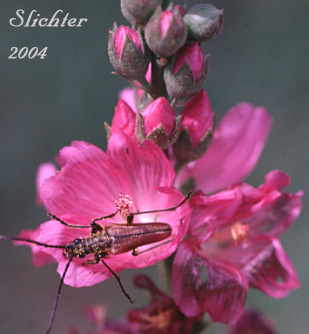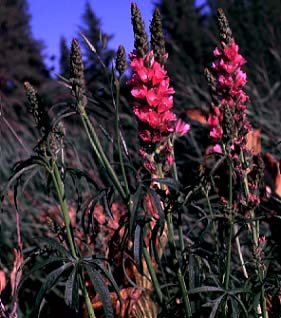

 Characteristics:
Characteristics:
Oregon checker-mallow is an attractive perennial wildflower suitable to vernally moist areas of a garden meadow or rock garden. Single or small clusters of erect stems arise from 20-150 cm high from a stout taproot. The stems are often simple but may be branched and are variably covered with fine star-like hairs, depending on the variety (See below.). The leaves have simple to two-forked hairs on their upper surfaces and star-shaped hairs below. The lower leaves are shallowly to deeply lobed, the lobes with further lobes or merely with rounded teeth. The uppermost leaves are parted into linear segments.
The racemes are loosely to densely flowered with stout pedicels that are typically shorter than the calyx. The pedicels range from 1-10 mm long while the calyx is 3.5-9 mm long. The calyx is finely and densely covered with star-shaped hairs or may be bristly with some longer, simple hairs mixed in. The pink to lavender corolla is up to 4 cm wide, with individual petals from 1-2 cm long.
To determine the varieties of Oregon checker-mallow, you will need to use a good hand lens and look at the type of hairs found on the stem, leaves and calyx.
var. calva: Base of stems glabrous or with some 4-rayed, appressed hairs. Leaves thick, fleshy and nearly glabrous. Calyx sparsely covered with star-shaped hairs. Found in the Wenatchee Mts. of central Washington.
var. maxima: Base of stems moderately to strongly covered with appressed, star-like hairs. Leaves and calyx usually uniformly covered with star-shaped hairs. Petals often less than 15 mm long. Found from central and southern Oregon to northern California.
var. oregana: Base of stems glabrous or sparsely covered with appressed, star-like hairs with 4-9 rays. Stems often glaucous. Petals usually over 15 mm long. Found from south-central Oregon east to Wyoming and south to northeastern California and Utah.
var. procera: Base of stem with simple, spreading hairs to star-like hairs that are not appressed to the stem. Inflorescence open, especially after flowering. Pedicels about 3 mm long, the calyx usually well over 6 mm long. Found in eastern Washington, adjacent Idaho and northern Oregon from the east base of the Cascade Mts. east through the Blue Mts.
var. spicata: Base of stem with simple, coarse, stiff hairs. Inflorescence dense and spike-like both in flower & fruit. Pedicels 1-2 mm long and calyx about 5 mm long at flowering. Found from central Oregon south to the southern Sierra Nevada Mts. of California.
Oregon checker-mallow may be found in riparian meadows, grasslands, amongst sagebrush, on bunch grass hills or in open ponderosa forests.
Oregon checker-mallow may be found east of the Cascade Mts. from central Washington south to northern California. It may be found eastward to Idaho, Wyoming and Utah. Several varieties not listed above may be found along the Pacific coast and in the Coast Ranges from southwestern Oregon to the central California coast.
In the Columbia River Gorge, variety procera may be found between the elevations of 200'-2000' from Hood River east to the Dalles, OR. Henderson found it growing in the Hood River Valley during the late 1800s, but I am unsure whether it can still be found there.